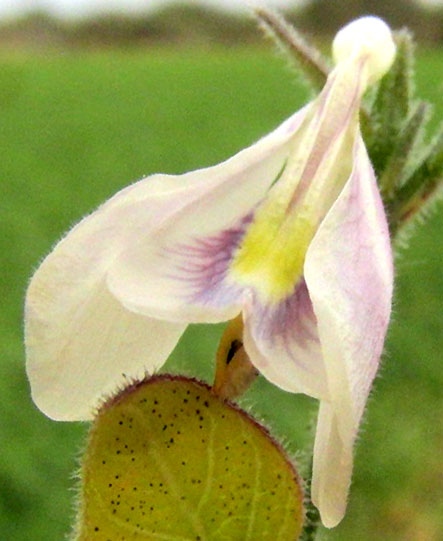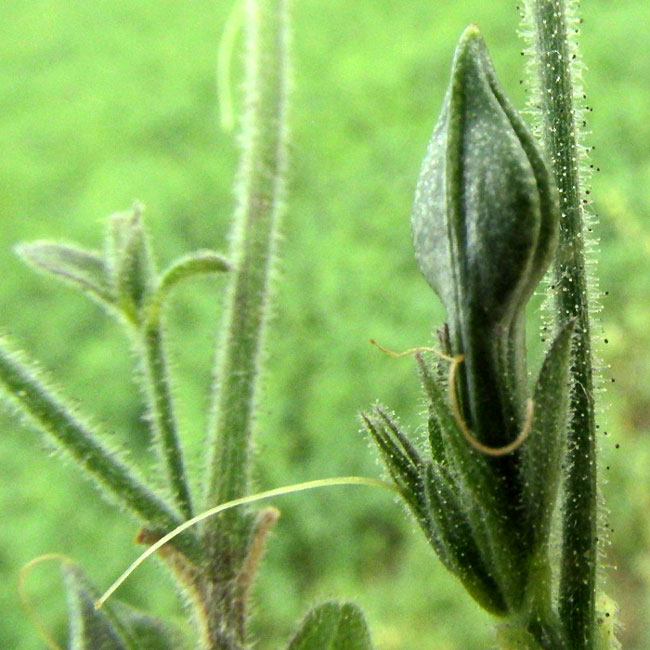Excerpts from Jim Conrad's
Naturalist Newsletter
entry dated December 20, 2022, issued from near Tequisquiapan, elevation about 1,900m (6200 ft), ~N20.57°, ~ W99.89°, Querétaro state, MÉXICO
VISCID WRIGHTWORT

Beside a dirt footpath through a weedy, shadowy thicket of mesquite much hacked by firewood gatherers, the above knee-high tangle of slender, stiff stems of a perennial herb amazed me with the ease the flowers' white corollas fell off. Most corollas appeared to have fallen off with no help. Finally a loosened corolla turned up that had lodged atop a leaf. Gingerly the stem was snipped and carried to a nearby field with better lighting, and below you can see the stranded corolla atop its leaf:

With the corolla's bilateral symmetry, I guessed the plant was a member of the big Bean Family, despite the plant bearing simple leaves not divided into subdivisions. Maybe it was the genus Dalea, which produces some simple-leafed species.

The above picture shows the corolla lodged atop a leaf below the flower, so that we're seeing it either from the corolla's normal top or bottom. The corolla as seen displays two large lobes partly wrapping around other corolla parts from the sides. These look like side "wings" on a Bean Family member's bilaterally symmetrical "papilionaceous" flower. In the picture, the purple veins radiating from a yellow zone appear on the undersurface of what normally is the corolla's top lobe. Possibly our picture provides a view of what would be the top of the corolla if it were still attached to its calyx, so we'd be seeing the yellow and purple coloring through the top lobe's thickness. Pictures on the Internet show the corolla with a very slender, white lower lobe, but that's not visible in our picture, nor are the stamens. Really I can't conceive of how the corolla is contorted to display what's seen in the picture.
With such a confused impression of the corolla, possibly I'd never have identified this plant if at least one plant hadn't produced a fruit:

When you see a capsular fruit like that shaped like an upside-down violin, the best bet is that you have a member of the Acanthus Family, the Acanthaceae. That family also produces many species that, when their corollas fall off, the long style is left conspicuously arcing away from the ovary it's growing atop of, and that's what the whitish, slender item is at the bottom left in the picture.
Suspecting we had a weedy member of the Acanthus Family, it was easy enough to find something very like our plant illustrated at the fine Malezas de México website, "Mexican Weeds." Though our flower was a little different from the plant featured at that website, Carlowrightia parvifolia, it was close enough to guess that our plant was a member of the genus Carlowrightia. Consulting the Acanthus Family treatment in the Flora del Bajío, which embraces our area, three Carlowrightia species were documented, and our plant easily "keyed out" to CARLOWRIGHTIA NEESIANA, at least at the Berkeley University CalPhotos website known in English as the Viscid Wrightwort. The main field mark for this species is its strongly bilaterally symmeterical corolla shaped like a papilionaceous flower of the Bean Family, the hairless fruit, and the hairy stems with many of the hairs topped by glands, as seen in the above photo.
The distribution map for this species at the GBIF page for Carlowrightia neesiana shows that the species is endemic just to central Mexico, mostly in the uplands. The Flora del Bajío describes its preferred habitats as arid scrub, deciduous tropical forest (like mesquite thickets), and pine and oak forests.
Having the name, now the plant could be looked up. In Thomas Daniel's 1983 revision of the genus Carlowrightia, entitled "Carlowrightia (Acanthaceae)," there's reference to our plants' corollas falling off so easily. With regard to several species he studied growing, he writes, "In both the field and the greenhouse, the corollas open between 7:00 and 9:00 a.m., shortly after which the anthers dehisce. Within four to five hours, each corolla falls from the plant."
Danel's revision -- though even still the final word on the genus Carlowrightia -- doesn't mention our Viscid Wrightwort species. That makes sense, because only in 1988, after Daniel's revision of 1983, was our plant shifted from the genus Cardiacanthus, where it had been assigned in 1847. As currently configured, the genus Carlowrightia holds about 26 species, which occur from the southwestern US south through Mexico to about Costa Rica.
The genus Carlowrightia is named after American botanist Charles (Carlos) Wright (1811-1885). At least one species has been used in traditional Mexican medicine against inflammation of tissue. The 2002 study by Delia E. Cruz-Vega and others entitled "Leaf extracts of Carlowrightia cordifolia induce macrophage nitric oxide production," lends some credence to that folk-medicine practice.